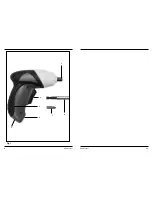
Powercraft
7
11. Never throw the accumulator block into water or a fire – it may explode.
12. Turn the drill immediately off after the screw is fastened. Overloading and damaging the
battery or motor can be prevented this way. Use the torque to loosen the fastened screw.
Inserting and removing bits
Fig. 1 + 7
The bits can easily be placed directly into the bit holder or on the extension piece. The
extension piece can be used for screws that are difficult to reach.
Always observe the safety instructions and applicable regulations.
Firmly hold the machine and ferm the bit with even pressure into the workpiece. Do not force
the machine. Use only bits that do not yet show any signs of wear. Worn bits have a negative
effect on the efficiency of the machine.
Locking the screwdriver
Fig. 8
The screwdriver is fitted with an automatic spindle lock feature. When the On/Off switch (2) is
not pressed, the spindle is locked. Now it is possible to use the screwdriver (even when the
battery is empty) as a manual tool.
Screwdriving
Fig. 1
To switch the tool on, press the On/Off switch (2).
-
Press the tumbler switch (R) for clockwise rotation (tightening screws)
-
Press the tumbler switch (L) for counterclockwise rotation (loosening screws)
To switch the tool off, release the on/off switch.
User tips for optimum use
•
Always hold the tool and screwdriver bit in a straight line with the screw and always use
the correct type and size of bit.
•
If screws are difficult to tighten, try applying a small amount of washing liquid or soap as a
lubricant (Fig. 9).
•
Use the spindle lock feature to loosen very tight screws or to firmly tighten screws.
•
When screwing in wood, it is recommended to drill a hole with a depth equal to almost the
length of the screw. A pilot hole guides the screw and prevents splintering or distortion of
the work piece.
4. OPERATION
3. ASSEMBLY INSTRUCTIONS
UK
6
Powercraft
The following symbols are used in these instructions for use:
In accordance with essential applicable safety standards of European directives
The charging adapter is double insulated in accordance with EN-60335;
therefore no earth wire is required.
Denotes risk of personal injury, loss of life or damage to the tool in case of non-
observance of the instructions in this manual.
Indicates electrical shock hazard.
Read instructions carefully
Indoor use only
In case of failure, the transformer is not dangerous
Thermic protector
Faulty and/or discarded electrical or electronic apparatus have to be collected at the
appropriate recycling locations.
ADDITIONAL SAFETY INSTRUCTIONS
1.
Only use the accumulator block with the battery charger provided – using other chargers
could be dangerous.
2.
Keep the accumulator block, tool and battery charger away from damp and wet
conditions.
3.
Before using the battery charger, check all wires are properly connected.
4.
If any wires on the charger are damaged, do not use it until these have been replaced.
5.
When the charger is not in use it should not be plugged in. When unplugging, do not pull
the plug out by the cable.
6.
If the charger breaks down or suffers from other technical problems, take it to a
recognised dealership to be checked before using it again. Any damaged parts must be
replaced.
7.
Take care when handling the accumulator block, do not drop it or knock it against other
things.
8.
Never attempt to repair the battery charger or accumulator block yourself; this can be
extremely dangerous. Repairs should always be carried out by a
recognised dealership.
9.
Always unplug the charger before cleaning or carrying out any other maintenance on it.
10. Do not attempt to charge the accumulator block in temperatures of below 5 degrees or
above 40 degrees centigrade.
2. SAFETY INSTRUCTIONS
UK






